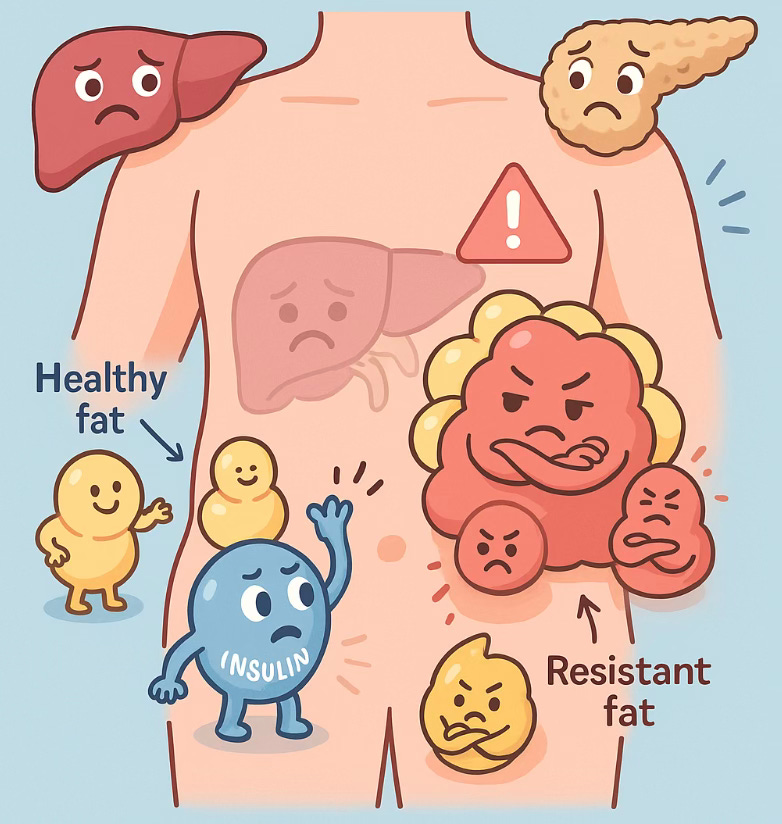Insulin Resistance Doesn’t Start with Carbs.
The Hidden Organ That Decides If You Become Insulin Resistant
You’ve been told this story before:
Eat too much sugar → blood sugar rises → insulin resistance kicks in → you get type 2 diabetes.
But… what if that story is missing the most important part?
What if it’s not really about sugar at all?
What if the real problem starts in your fat—quietly, invisibly—long before your blood sugar goes off the rails?
The Invisible Battle Happening Inside You
Let’s start with something weird.
Two people. Same height. Same weight. Eat the same food. Exercise the same amount.
One of them is developing insulin resistance. The other isn’t.
Why?
It’s not about how much fat they have.
It’s about what kind of fat they’re growing.
Fat Isn’t Just Stored Energy. It’s a Living System.
Most people think fat is like stuffing in a pillow—just sitting there, doing nothing.
Not true.
Fat is alive. It talks to your brain. It talks to your immune system. It sends chemical messages all over your body.
And most importantly?
It makes decisions.
The biggest one?
When you gain fat, will your body make more fat cells—or just stretch the ones you already have?
That one choice can determine whether you stay healthy… or quietly slide toward insulin resistance.
Two Very Different Kinds of Fat Growth
Here’s where things get interesting.
When your body stores extra energy (like after eating), it can grow fat in two ways:
1. Hyperplasia – The Good Kind
Your body creates new fat cells to handle the extra energy. These new cells are small, well-behaved, and don’t mess with insulin.
2. Hypertrophy – The Dangerous Kind
Your body doesn’t make new cells. Instead, it crams more fat into the cells you already have. These swollen cells get sick. They get inflamed. They stop listening to insulin.
Imagine you’re packing for a trip.
Hyperplasia is like buying a new suitcase.
Hypertrophy is like stuffing everything into one bag until the zipper breaks.
Why This Matters for Insulin Resistance
Here’s the connection.
When fat cells get too big, they:
Can’t get enough oxygen (they basically suffocate)
Start leaking stress signals
Call in immune cells to “clean up the mess”
And eventually tell your body: “Stop listening to insulin!”
That’s how insulin resistance starts.
Not because of sugar.
Because your fat cells couldn’t keep up.
Wait—How Do I Know What My Fat Is Doing?
Great question.
You can’t feel it. You can’t see it. But science has figured out the clues.
People with healthy, smaller fat cells (from hyperplasia) tend to:
Handle carbs better
Have less inflammation
Stay more insulin-sensitive—even if they’re heavier
People with overstuffed, hypertrophic fat cells tend to:
Be insulin resistant—even at a normal weight
Have more fat around the liver and organs (called “ectopic fat”)
Feel more tired, inflamed, and out of balance
This is why your lab work matters more than your mirror.
You Have a Limit: The Personal Fat Threshold
Here’s something nobody told you in health class:
Everyone has a limit—a point where your body says, “I can’t store any more fat safely.”
Scientists call this the Personal Fat Threshold.
If you cross that line, your fat spills into the wrong places: your liver, your muscles, your pancreas, and even your heart. That’s when insulin stops working right.
Some people hit that limit at a BMI of 22. Others at 35. It’s not about size. It’s about capacity.
Ready to Find Out What Your Fat Is Really Doing—And How to Fix It?
Most people try to treat insulin resistance by chasing blood sugar.
But that’s like bailing water from a sinking boat… without patching the hole.
If your fat cells are overwhelmed, inflamed, or storing energy in the wrong places—nothing else will work.
That’s why I created the “Decode & Reset Your Fat Function” Worksheet—and why I want you to have it inside the Inner Circle.
Inside, you’ll get:
A self-assessment to spot early signs of dysfunctional fat storage
The exact labs to request (and what optimal really looks like)
A step-by-step formula to calculate your own insulin resistance
A simple guide to check your visceral fat risk—at home
A proven food list to retrain your fat cells (no calorie counting, no fads)
A 1-day sample meal plan that’s high in fiber, low in glucose spikes
A weekly tracker to monitor energy, progress, and habit consistency
But that’s just the beginning.
As an Inner Circle member, you’ll also get:
Weekly mindset and behavior science articles that go far beyond what’s available to the public
Advanced strategies to break stuck patterns and heal from the inside out
Monthly tools and trackers grounded in science—but written in plain English
Early access to new challenges, guides, and courses
Direct insight into how I help patients build lasting metabolic health—without diets, gimmicks, or willpower
This is not just information. It’s transformation.
Download the worksheet. Run the labs. Follow the plan.
Track what happens in 30 days—and never miss the next step.
Become an Inner Circle member and get instant access now.





